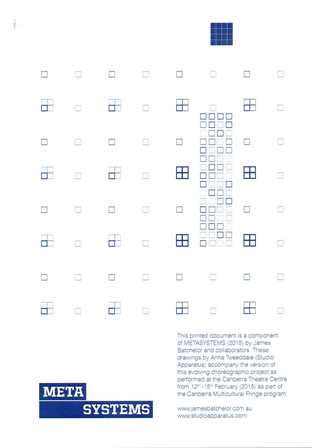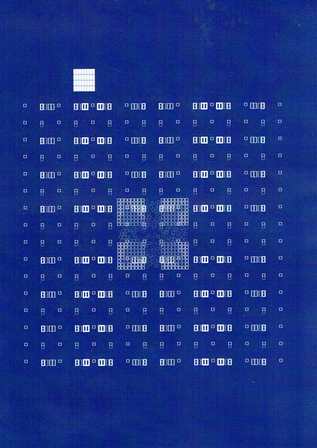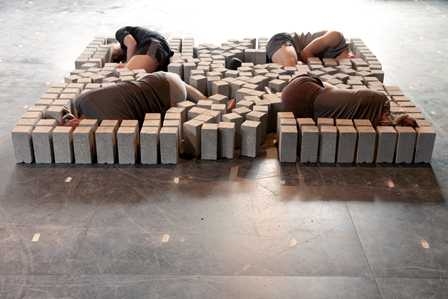12 February 2015. Courtyard Theatre, Canberra Theatre Centre as part of Canberra Multicultural Fringe
James Batchelor began working on Metasystems in 2014 for the inaugural Keir Choreographic Award, an award dedicated to commissioning new work and promoting innovation in contemporary dance. Batchelor was a semi-finalist in the award. A longer version of Metasystems was recently performed in Canberra as part of the Canberra Multicultural Fringe, and in conjunction with ‘Pulse: reflections of the body’, an exhibition at the Canberra Museum and Gallery. I have briefly commented on Batchelor’s involvement with Pulse elsewhere. Below is an expanded version of my review of Metasystems, originally published in The Canberra Times on 14 February 2015.
James Batchelor’s Metasystems appears to be an austere work about construction and deconstruction. Four performers spread two piles of concrete bricks across the floor of the performing space. Two different kinds of bricks, both concrete, are used during the performance—regular-sized house bricks, and Besser blocks. They are arranged in meticulously laid out but changing patterns. Part of the handout as we enter the theatre is a card bearing a plan by architect Anna Tweeddale of potential arrangements. Visual artist Madeline Beckett also worked on the design of the system of stacking and unstacking the bricks.


We usually hear a deliberate thump as each brick is placed in position, although at times the performers move the bricks as silently as they can. We watch as the bricks are rearranged over the course of the performance. It all seems to be working according to a mathematical formula, although one or two minor mishaps spoilt the purity of the arrangement on opening night.
Two of the performers, James Batchelor and Amber McCartney, have a dual function. They not only assist the other two performers, Madeline Beckett and Emma Batchelor, in laying out the bricks, but there are times when they dance between and around the rows and piles of bricks. Their movements take on an expressive function, often mirroring in dance the construction and the shape and placing of the bricks. Particularly absorbing is a sequence in which the bricks are arranged into long channels—lines of single bricks placed upright on the floor. James Batchelor and McCartney squeeze themselves into the channels and worm their way down the narrow spaces from top to bottom while occasionally balancing parts of the body precariously on the top of the bricks.
Two aspects of Metasystems stand out. Firstly, inherent in this work is a powerful understanding of body time. With no music and not always even the steady thump of bricks on the floor to guide them, Batchelor and McCartney frequently dance in unison without obviously watching each other. They sense the timing of the other and rarely falter.
Secondly, the work ends in an unexpected way. Having watched some 45 minutes of walking and brick-carrying, it is something of a shock when, as the work is concluding, the dancers separate out an individual space for themselves within the final arrangement, a tightly knit square of bricks. They then snuggle down into the construction. Suddenly something personal is injected into the show, even a hint of emotion. It is the human element inhabiting the built environment and disturbing its mathematical precision.
It occurred to me only later that the earlier confrontation with the bricks, as McCartney and James Batchelor wriggled their way down those narrow spaces between the bricks, touching them occasionally and taking care not to disturb them, that this too was part of a human engagement with the built environment.
That Batchelor can surprise like this is what makes his work so worth following.
Michelle Potter, 18 February 2015
Featured image: Final scene from James Batchelor’s Metasystems. Photo: © Anna Tweeddale, 2015
